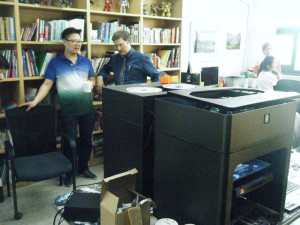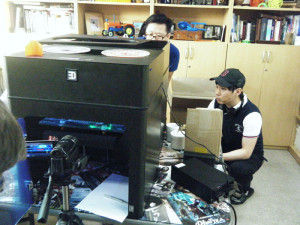In April we promised you a follow up story on the new line of printers released by Rokit, the South Korean 3D printer maker, once we had a chance to see them up close. Well, we got our chance when the Rokit crew visited one of our local university campuses. We not only got to see their new Edison Pro model, but also had the chance to talk a little more with their crew about what the company is doing and where they are planning on going.
As our readers may recall, Rokit is a young start-up company in South Korea (something of a rarity to begin with) that focuses on the manufacturing of 3D printers. They began a few years ago when their CEO, Yoo Seok Hwan, started the company after learning about 3D printing and became an enthusiast. He is now scheduled to be one of the key speakers at this year’s Inside 3D Printing Conference and Expo in Seoul, South Korea on June 12th and 13th. Full details can be found at the conference website.
From their small beginnings, they have grown quite quickly, and now employ over 50 people and are currently looking for a new manufacturing facility that can accommodate their growth. In listening to the story of their beginnings, I couldn’t help but be struck by several parallels to the MakerBot genesis story. The long, slow startup, the sudden explosion of activity and rapid growth, the race to keep up with demand…. Two companies, on the opposite sides of the planet, experiencing nearly the same set of challenges and problems…it was fascinating.
Currently the company is “swamped” with, as it turns out, mostly foreign orders. The bulk of the orders are coming from Japan, Turkey, Africa and Russia, among others. We were told that in a few cases, resellers in Japan and Turkey have dropped 3D Systems Cubes and have signed reseller contracts with Rokit. According to an announcement by Alterna, a Russian company that has signed an exclusive distributorship deal with Rokit, the Edison is twice as fast, has twice as good resolution, and yet its price is two times lower than competitive models available. The announcement (in Russian) can be found here.

Rokit is also attempting to help spread 3D printing knowledge by instituting an “Edison Creativity Development Fund” which donates 3D printers to select recipients. According to Park Hee Wan, Director of Sales, the program collects and puts aside $10 from the sales proceeds of each printer sold. This money is then used to finance the donation of an Edison Plus printer to selected applicants who have a need for such a machine. The application process can be accessed through Rokit’s Facebook page or their website here.
The new Edison Pro we saw was an impressive machine both for its looks, and more importantly, for its versatility. The machine is fairly large, about twice the size of a Makerbot Replicator 2, but has a sleek aluminium case with a build chamber door giving it a more “appliance-like” appearance than many other printers currently available. The overall design seems to have been carefully thought out, resulting in a very sleek (although somewhat large) device. There are no exposed spool holders, wire bundles, or exterior attachments to detract from its otherwise smooth appearance.
When we looked inside, the interior of the machine was likewise clean and obstruction free…almost cavernous. It had a 300 x 205 x 250 mm build area and almost all of the functioning parts were designed for, and fitted, in the upper half of the machine. The dual filament spool, the X and Y gantry assembly and even the control board are all in the upper half of the machine. This left the build area open and obstruction free. The printer, while having a sealed build chamber, sits directly on the table top and has no base plate, meaning cleanup is as easy as lifting the printer up and sweeping the printing detritus away. Cleaning most printers involves brushes and cans of dust-blow to get all the little particles of plastic trash out of the build areas…and is generally a real pain.

Of course, as we told you last time the Edison Pro also features a self-cleaning and automatic bed-levelling feature, an embedded battery backup to protect against power failures, dual extruders, internal LED lighting, a WiFi camera, heated build platform, a resolution of 25 microns and a 3 watt laser engraver/cutter. While all of that was great, one of our favorite features was an integrated temperature display on the heated build plate, so you can simply look at the build plate and know what temperature it is currently operating at. We were told this was done to help reduce burned fingers and because it allows for greater operator control over the build process and was found to be useful…which seems obvious.
Quality of the machine’s construction aside, one of the biggest drivers of interest in the Edison seems to be the wide variety of materials that it can use. In the demonstration we saw, the Rokit crew first used PLA filament, then switching print heads, and changed to a copper metal paste. Switching print heads was easy, involving the removal of two base screws from the printhead carriage, unplugging the printhead’s electrical lead, swapping the heads, returning the screws and plugging in the new lead. That was it. With this quick-change feature, the printer can consume a huge array of materials…everything from PLA, ABS, Nylon, HIPS, specialized engineering polymers, wood and stone filaments to metal, ceramic, chocolate and even food pastes. The list was huge with over 50 types of materials being listed so far, and according to what we were told, is getting longer every day as they are actively researching new materials. If it comes in, or can be put into, either filament or paste form the Edison Pro can probably use it.
Having cut our teeth on a Replicator 2, good as it was, we had to go through an extended period of self-teaching and troubleshooting. Earlier printers were very finicky and somewhat temperamental, prone to “mysterious” breakdowns and stoppages. While many of us in the 3D printing community embrace such challenges as part of the experience, newer members are not so enthusiastic. I have spoken to many people who “flaked off” after their initial 3D printing experience due to frustration with hardware troubles. While FDM (or FFF if you prefer) is improving in resolution and speed, the items produced have a certain quality to them that has remained fairly unchanged…so to us, speed and resolution are not the most important features of a newer printer.
The most important features are ease of use and reliability. One young woman who was present at the demo, while happy to see the new machines, said she wasn’t really impressed by the overall quality of the prints, saying that they looked similar to the prints she had seen from other printers. But as it turned out, while she had seen other printers, she had almost no experience using those printers…and as such didn’t appreciate the level of skill required to produce a high quality FDM print on an older machine. It is likely that if she had tried using an older machine, she too may have joined the ranks of 3D flakers and missed out on the possibilities that the technology presents.
The Edison Pro, and other quality machines like it, may help to open up this “exclusive” club of skilled printers to a far wider group of participants. A few months ago during a class where 3D printing was being discussed, one student said, “When they (3D printers) become microwave-easy to use, then I will get one.” Well…that time might just have arrived.


